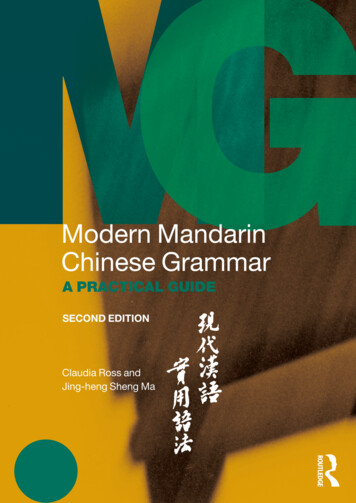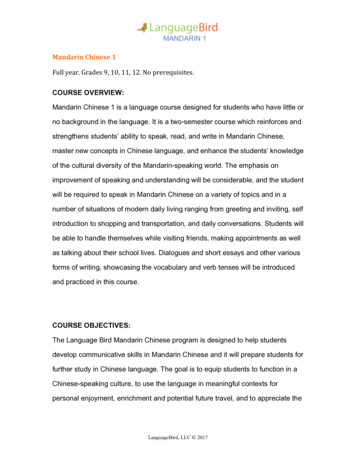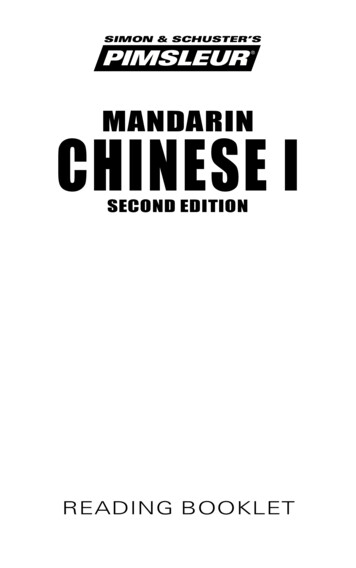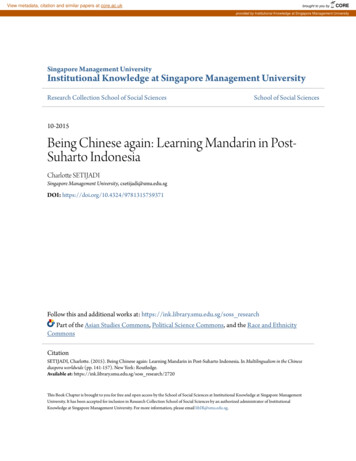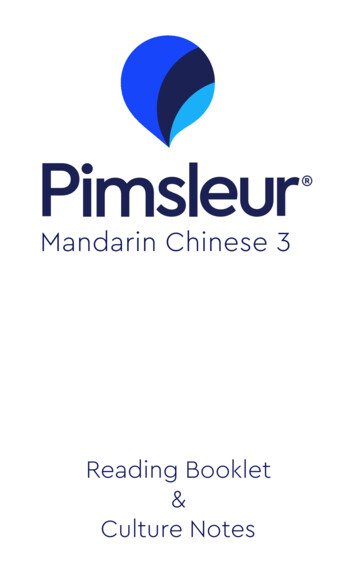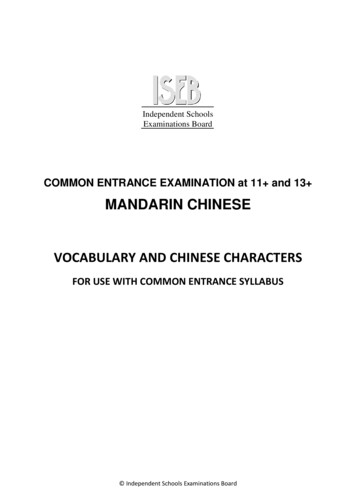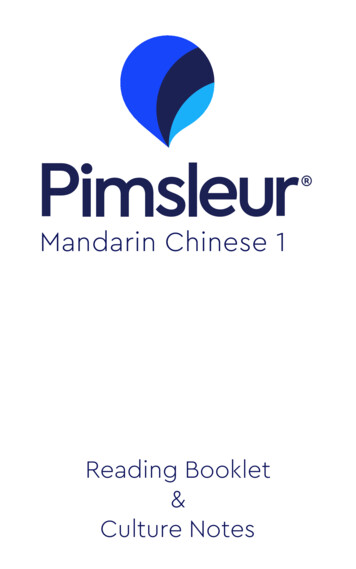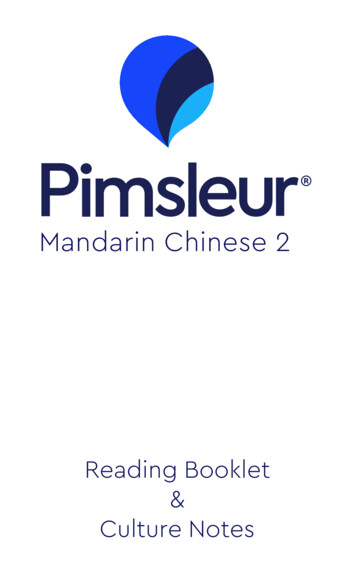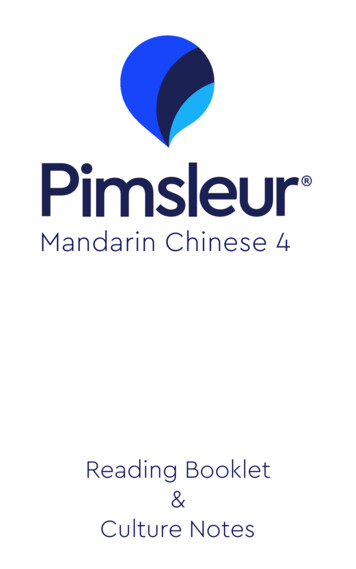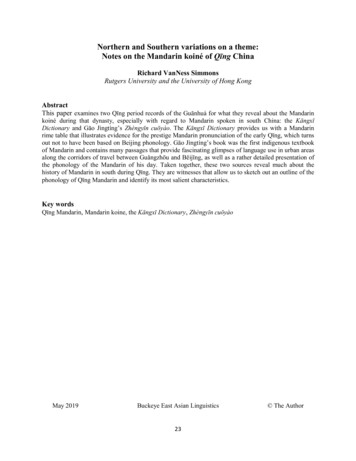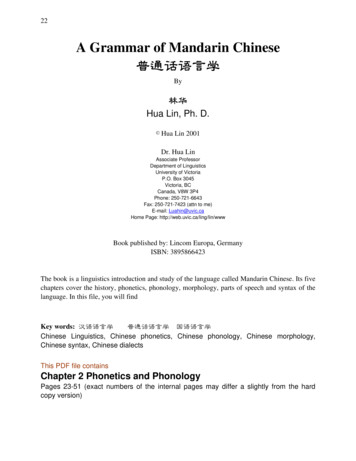
Transcription
22A Grammar of Mandarin Chinese普通话语言学By林华Hua Lin, Ph. D. Hua Lin 2001Dr. Hua LinAssociate ProfessorDepartment of LinguisticsUniversity of VictoriaP.O. Box 3045Victoria, BCCanada, V8W 3P4Phone: 250-721-6643Fax: 250-721-7423 (attn to me)E-mail: Luahin@uvic.caHome Page: http://web.uvic.ca/ling/lin/wwwBook published by: Lincom Europa, GermanyISBN: 3895866423The book is a linguistics introduction and study of the language called Mandarin Chinese. Its fivechapters cover the history, phonetics, phonology, morphology, parts of speech and syntax of thelanguage. In this file, you will findKey words: 汉语语言学普通话语言学 国语语言学Chinese Linguistics, Chinese phonetics, Chinese phonology, Chinese morphology,Chinese syntax, Chinese dialectsThis PDF file containsChapter 2 Phonetics and PhonologyPages 23-51 (exact numbers of the internal pages may differ a slightly from the hardcopy version)
Hua LinA Grammar of Mandarin Chinese23Chapter 2. Phonetics and PhonologyThe study of the sound system of language normally starts with phonetics followed byphonology. However, it is widely acknowledged that the two are not mutually exclusive: Thequality of phonological modeling crucially depends on the understanding of phonetic details,whereas phonetic description is often more insightful when done within a more explanatoryframework of phonological constraints, rules and/or parameters. In this chapter, we will notattempt to separate the two, but each will be resorted to as required by the description andexplanation of certain aspects of the Mandarin sounds and their patterns.The theoretical framework used in this chapter will be Generative Phonology, a majorinfluential phonological framework developed in the twentieth century. Within this framework, asound (or in proper linguistic terms, a phone or a segment) is a bundle of binary features whichencode such information as the position where the sound is produced (where the stricture is) bythe speech organs and the manner in which the sound is uttered. Phonological processes arecaptured in terms of change in the configuration of the feature bundles in certain contexts. Thistheory of the sound patterns of language has gone through a great deal of change within the pasttwo decades. An example of such change is that the place features, which used to be binary instandard Generative Phonology (Chomsky and Halle 1968), are now unitary features. Thearrangement of features has also been completely revolutionized. To denote a segment, say [p],the features used to be placed, unordered, in a two-dimensional feature matrix such as this,(2.1) consonantal-sonorant-continuant-voiced labial but they are now organized into a three-dimensional tree structure which branches out into severallevels from a root node carrying the crucial information as to whether the segment is a consonantor a vowel. The same information given in (2.1) would be organized roughly as (2.2): 11This is a much simplified feature geometry tree, though adequate to illustrate here the difference between the oldand new treatment of features. Interested readers may read Broe (1992) and Halle (1992) for details.
24Hua Lin(2.2)A Grammar of Mandarin Chinese consonantal-sonorant-continuant-voicedPlace LABPhonological processes used to be described by rules in the form of 'A becomes B in theenvironment of C', but now may be indicated by lines linking among the nodes of features. Thefollowing dotted line represents a phonological process whereby the second segment assimilatesthe place feature of the first.(2.3)Place LABPlace DORThis newer version of Generative Phonology is more complex and abstract. Theunderstanding of it entails a great deal of background knowledge of the various aspects of thetheory. Because the scope of this descriptive grammar does not allow a full introduction of thisnew theory, for ease of comprehension on the part of the general reader, we will now and thenadhere to more traditional ways of describing phonetics and phonological processes. The newertheory will be used where necessary, especially where the older theory is silent about the issuesinvolved or is entirely inadequate.This chapter addresses four aspects of the sound system of Mandarin: sounds, syllables,segmental processes and tone. The section on sounds will include the consonants, vowels, andglides. The section on the syllable will address such topics as the initials and finals, phonotacticconstraints, syllable weight, etc. The third section discusses the phonological processes that occurbetween adjacent segments within a syllable. This section will also address the phonologicalversus phonetic representation of phonemes and allophones in the Pinyin transcription system.The section on tone consists of two parts, one devoted to the four basic tones and the other to theneutral tone.2.1The SoundsA description of the phonetics and phonology of a language cannot be done without
Hua LinA Grammar of Mandarin Chinese25resorting to the linguistic tool called the phonetic features. Each sound or segment 2 is identifiedby a unique set of distinctive features organized in a tree structure. Features can be contrastive inone language, but not in another. Some of the most important distinctive features for thedescription of Mandarin include 1) major features such as [ consonantal], [ vocalic],[ aspiration], and [ nasal]; 2) place features: [LABIAL], [CORONAL], and [DOSAL]; and 3)vowel features: [ high], [ back], and [ round]. 32.1.1ConsonantsThe phonetic features that distinguish consonants from vowels are [ consonantal] and[ vocalic]. While consonants are [ consonantal, -vocalic], vowels are exactly the opposite: [consonantal, vocalic]. There is a third group of phonemes called glides or semi-vowels that havenegative values for both features: [-consonantal, -vocalic]. Strictly speaking, Mandarin has 20phonemic consonants. 4 Traditionally, the [-consonantal] glides are grouped with the consonants.As the glides [w, y, ÿ] are not phonemic in Mandarin, we have chosen not to include them here,but will deal with them at a later point in this chapter.placeLabialMannerStop[ asp]p t k ptkaffricate[-asp][ asp](2.4)[-asp]fricative[ asp]fdentalalveolar alveopalatalts t tst s [-asp]approximantnasalliquidretroflexpalatal velarx mn l Two major parameters are used in phonetics to differentiate sounds in language: place ofarticulation and manner of articulation. An important feature in the dimension of manner ofarticulation in Mandarin is [ aspiration] ([ asp] for short), denoted here by a superscript2In autosegmental phonology, the segment does not have to be a fully specified pronounceable segment, but a partialone, a theory that will not be expounded here.3These vowel features are terminal features of [LAB] ([round]) and [DOR] ([high] and [back]). See Broe (1992) fordetails.4The three palatal obstruents [t , t , ], which normally appear in a Mandarin table of consonants, are excludedhere because they are not, strictly speaking, phonemic. They will appear later in a more inclusive table in the sectionon variations of phonemes (Section 2.3).
26Hua LinA Grammar of Mandarin Chinesediacritic 5 ' ', that divides the obstruents (stops, affricates and fricatives) into two groups: thosethat are aspirated and those that are not. In physical terms, aspirated consonants involve a strongpuff of air coming out of the lungs, whereas unaspirated consonants do not have this trait.Regarding the difference between the alveopalatal fricatives [ ] and [ ], there has beencontroversy. Textbooks and grammar books published in the People's Republic of China (e.g.,Wang and Pang 1996, p. 156) distinguish the two in terms of [voicing]; namely [ ] is voicelesswhile [ ] is voiced. However, that would mean the positing of a voicing feature which isotherwise unwarranted for the Mandarin obstruents. One way to avoid this theoretical inadequacyis to assume that [aspiration] is the feature which distinguishes the language's fricatives as withthe other obstruents. This is the position held by many linguists outside China, and is adopted inthe table above. It is interesting to note that [aspiration] as a distinctive feature is often hard tocomprehend by speakers of a language making a distinction among its obstruents in terms ofvoicing rather than aspiration. For instance, to a speaker of English, the aspiration distinction inMandarin sounds indistinguishable from the voicing distinction in English. The reverse situationis true for native-Mandarin-speaking learners of English.From the point of view of place of articulation, the consonants can be classified into threemajor groups: [LABIAL] (or [LAB] for short) which include the labials, [CORONAL] (or [COR]for short) which include the dentals, the alveolars and the alveopalatals, and [DOSAL] (or[DOR]) which include the rest. The [COR] alveopalatals [t , t , , ] are a special case. Thesesounds are similar to English [t , d , , ] (the initial consonants in church, judge, ship and genre,respectively) in place and manner of articulation, but are different from their English counterpartsin that they are pronounced without the protruding of the lips but instead with the additionalfeature of curling the tip of the tongue toward the front of the hard palate. The latter characteristicmakes them [retroflex] sounds. Mandarin spoken as a second dialect in non-Mandarin-speakingareas, particularly in the Southeast provinces of China, normally does not have this [retroflex]feature. Taiwan Mandarin, for one, clearly lacks this feature.2.1.2VowelsMandarin has a relatively small set of phonemic vowels, compared with some otherChinese dialects (e.g., Shanghai). There are six phonemic vowels 6 which are given kunroundrounduoaAnother very common way of transcribing aspiration is the use of the 'prime' sign, with which the aspirated [p]would be [p'].6The vowels after the sibilants [ts , ts, s, t , t , , ] are dealt with later in this chapter.
Hua LinA Grammar of Mandarin Chinese27Three features are sufficient in distinguishing the phonemic vowels in Mandarin:[backness] (front/back), [height] (high/low) and [roundness] (round/unround). Unlike many otherChinese dialects, Mandarin has two high front vowels, [i] and [ ]. While [i] is a very commonvowel similar to the English vowel in beat, [ ], which is pronounced with the tongue positionedas in [i] and the lips positioned as in [u], is not as common. Not only is it often absent from otherdialects of Chinese, but it is also occasionally absent from Mandarin as spoken in Taiwan. Thus,one sometimes hears n&p5ngy0u 你朋友 '(literally) you friend' in place of the targeted n p5ngy0u女朋友'girl friend' in Taiwan Mandarin.The mid-vowel / / is often substituted for the English schwa [ ] by an English-as-asecond-language (ESL) learner whose mother tongue is Mandarin. Both are non-rounded midvowels, but the Mandarin one is tenser and further back in the oral cavity. The low vowel /a/ isfairly similar to the English vowel [a] in father, the mid vowel /o/ to that in boat, and the backvowel /u/ to that in boot. All five vowels have contextual variations, a topic to which we willreturn shortly.2.2The SyllableOne of the most remarkable phonological characteristics of Mandarin (and the Chineselanguage in general) is the salience of its syllable. The following quote from Jerry Norman (1988)is typical of linguists of Chinese:'There is a sense that Chinese is also phonologically monosyllabic. Inalmost all descriptions of Chinese, the syllable is taken as a kind of self-containedentity which forms the basis of phonological description. In historicalcomparison, [the syllable] is the largest relevant unit; another important feature ofChinese dialects (and perhaps of other monosyllabic languages as well) is that anyone dialect contains a fixed number of possible syllables. Even when new termsare borrowed from foreign languages, they are interpreted in terms of the existingset of syllables. A further consideration is that most phonological processes affectthe syllable without reference to its lower level constituents.' (p: 138)What is also remarkable about the Mandarin syllable is that there is a very limited numberof them, just a little more than 400 the official figure from the PRC is 405 when tonaldifference is disregarded. These 405 syllables are given in the Table of Beijing Sounds andSyllables below:
Standard Table of Beijing Sounds and enzhang zheng zhongzhuzhuazhuozhuaizhuizhuanzhun zhuangchouchanchenchang chengchuchuachuochuaichuichuanchun chuangshaoshoushanshenshang shengshushuashuoshuaishuishuanshun ingqiongquque quanqunxxixiaxiaoxiexiuxianxinxiangxingxiongxuxue xuanxunyuyue 28yanyinyangyingyongweng
29Even when tonal difference is considered as a difference in syllable type, there are only about1200 types. This number is remarkably small in contrast to that in English, which has more than8,000 syllable types according to one source (De Francis 1984). One consequence of this paucityof syllable types is that in Mandarin there are a great many homophones, especially at themorpheme level. We will return to this topic of homophones in the next chapter.2.2.1The Initial And the FinalThe Chinese syllable has been the substance of scholarly studies for centuries in China. Asparticularly evident in such rhyme dictionaries as Qieyun (Lu Fayan, A. D. 601), a Chinesesyllable is traditionally seen as having two parts: the initial (sh4ngm} 声母) and final (y]nm} 韵母). 7 The initial is usually the single consonant found at the beginning of a syllable while thefinal everything that follows. The initial may be empty, or a 'zero initial' (l ngsh4ngm} 零声母)in which case, the initial consonant is absent, and the syllable begins with a vowel 8 which is stillconsidered to be part of the final.The division of a syllable into just two parts seems to be psychologically real in thesubconscious linguistic knowledge of native Mandarin speakers. Studies (e.g., S. Wang 1993)have shown that Chinese who have not learned an alphabetical system such as Pinyin or thewriting system of English cannot further segment a Chinese syllable final into its componentsounds 9 suggesting the integrity of the Chinese final. This bipartitional approach to syllablesegmentation is still largely used in the dialect studies of Chinese in the People's Republic ofChina. There, in almost all books of dialect studies—a great number of which have beenproduced during the last ten years, one can find lists of all the initials and all the finals of thedialects under study.Scholars of the Chinese language perhaps would have been content with the initial-finalpartition of the Chinese syllable, had not Western linguistics been brought to China by suchpioneering modern linguistic researchers as Yuen Ren Chao (or in Pinyin, Yuanren Zhao) early inthe Twentieth Century. Today, many grammar books published in the People's Republic of Chinareflect the influence of modern linguistics from the West. One example is that in many grammarbooks, the Mandarin syllable is described in finer details, which we have distilled in the followingnotation:7Qieyun 切韵 also indicates the existence of tone over the syllable. We will address tone later in this chapter.The vowel may change into a glide. See the sections on vowels.9Samuel Wang found that some native speakers of Taiwanese, a subdialect of Min (or Fukienese) could not evensegment a Taiwanese syllable into its initial and final. However, given the existence of many secret languages,language games and speech errors which move finals around, it is indisputable that initial-final segmentation ispsychologically real.8
30Hua LinA Grammar of Mandarin Chineseσ(2.6)Initial(C)Final(G)V({C, G})Where G is a contextual variation of a high vowel, andC in the Final is a nasal consonant.Among the symbols, 'σ' represents a syllable, C a consonant, V a vowel, and G a glide(which is a contextual variation of a high vowel). The use of the braces indicates that all but thenucleus vowel V is optional in a syllable; the use of the curly brackets means that only one of themembers enclosed can appear at a time. The above schema, if spelt out, yields the following 12syllable structures in Mandarin. For consistency, all examples given are first-toned monosyllabicwords: 10(2.7)Syllable TypesExamplesIPACGVCpy nPinyinbianCGVG w yshuai摔'break'CVCf feng风'wind'CVGCGVxeyt yaheijia黑家'black''family'CVt ata他/她/它'he/she/it'GVCy nyan烟'smoke'GVGw ywai歪'not 凹屋'convex''house'边'side'The three parts which form the final of a syllable have been referred to as the 'head'y]nt9u 韵头, (or 'medial' ji7y%n 介音), the 'middle' y]nf} 韵腹 and the 'tail' y]nw6I 韵尾10Please refer to (2.16) for the use of phonetic symbols for glides (e.g., [y]) in this chapter.30
Hua LinA Grammar of Mandarin Chinese31respectively. The head is a high vowel variation of a glide [y], [w] or [ÿ]. 11 The middle is any oneof the vowels when a glide is not present. When it is, the middle is a non-high vowel. The tail hasfour forms: a glide [y] or [w], or a nasal [n] or [ ].Depending on what sound starts them, the finals have traditionally been classified intofour groups: 1) the 'open-mouth finals' (k ik0uh[ 开口呼) which begin with a non-high vowel(i.e., [a], [o] or [ ] ), 2) the ‘close-teeth finals' (q ch&h[ 齐齿呼) which begin with the high frontunround vowel [i], 3). the 'close-mouth (lip-rounding) finals' (h5k0uh[ 合口呼) which begin withthe high back rounded vowel [u], and 4) the 'tense-lip finals' (cu8k0uh[ 撮口呼) which beginwith the high front rounded vowel [ ]. The columns of the Standard Table of Beijing Sounds andSyllables, given in (, are normally arranged based on this four-way division. Mandarin finals havealso been classified into simple finals, complex finals, and nasal finals. A simple final containsonly one vowel. A complex final consists of a diphthong (two-vowel sequence 12 ) or a triphthong(three-vowel sequence). A nasal final ends in a nasal consonant. In Pinyin, the Mandarin finalsare given below:(2.8)Type anguengüanünAs shown above, a number of finals contain diphthongs. A noteworthy property of thesetwo-vowel sequences is that, compared with similar strings in English, they are much more fused.A final with them often sounds more like single vowels (or monophthongs) to the ears of a nativeEnglish speaker. For instance, the ai in 'Shanghai' is said with a lot less transition from thevowel to the glide than the similar [ay] in 'bye' in English. Thus, a native English speaker, whensaying the word 'Shanghai', sounds to be exaggerating the ai to a native Mandarin speaker.1112These glides are sometimes represented by [j], [w], [ ] respectively in previous works on Mandarin phonetics.One of the vowels appears in the form of a glide (see later in this chapter for details).31
32Hua LinA Grammar of Mandarin ChineseAnother notable matter in the above table is that there is a special final that is not included in it: er . The reasons for the omission are: One, it does not belong to any of the groups in the table.Two, morphemes/words that take er as their syllable final are so few as to be marginal. Three,it can only occur alone neither with an initial consonant nor with a prevocalic glide.The traditional initial-final division of the Mandarin syllable resembles the well-citedanalysis of syllable structure in modern linguistics, as given below:σ(2.9)onsetrhymenucleuscodaIn this analysis, a syllable is first partitioned into an 'onset' and a 'rhyme' (also spelt 'rime').The rhyme is further divided into a 'nucleus' vowel (or the 'peak') and a 'coda' the finalconsonant or consonants of the syllable. Initially, one may think that 'onset' and 'rhyme' can beregarded as being the same as 'initial' and 'final'. However, they are not quite identifiable as willbe seen in what follows.Several questions about the constituents of the Mandarin syllable can be raised within thesyllable analysis in (2.9). One of the most well-known is where the prevocalic glide goes. Thisquestion has never been raised within the traditional initial-final framework, in which the glide isclearly indicated to be part of the final. There are at least two schools of theory regarding thisissue. One treats the prevocalic glide as a secondary feature of the onset (S. Duanmu 1990), theother, the more traditional, considers it part of the nucleus. To understand this controversy, weneed to digress a little to see another important characteristic of Mandarin syllables: that they allweigh the same.It is clear from the table in (2.8) that Mandarin syllables may contain from 1 to 4 sounds,and there are altogether twelve patterns for their combination. However, these facts should not beconstrued as meaning that Mandarin syllables vary in weight. The truth is that, unlike many otherlanguages in which the numbers of Cs and Vs (or Gs) in a syllable matter in the weight of thesyllable, the weight of the Mandarin syllable remains constant across syllable types within aspecific context of utterance. Thus, the metrics in Mandarin poetry do not normally count thenumber of sounds in a syllable, although they require the tone (a topic which will be addressedlater) to be more or less of a certain type in a given environment.During the last decade, linguists have tried to capture the same-weight phenomenon inmore formal terms. One way of doing this is to say that within the syllable, there is a fixednumber of timing slots. For instance, [ w y] 'break', [ya] 'duck' and [u] 'house' would all havethree timing slots within the syllable:32
Hua Lin(2.10)A Grammar of Mandarin Chinese33σ/ \XXXDepending on the theory one adheres to, the timing of a syllable can be analyzed andrepresented in several ways. What is shown above is one which uses a 'place holder' symbolizedby 'X', to encode one timing unit within a syllable. With just three timing units, a questionemerges immediately: how should the connection be made between these timing units and theactual Cs, Vs and Gs in Mandarin? The following illustrates the problem more visually:(2.11)σ/ \XXX w yσ/ \XXX yaσ/ \XXX uIf the first timing slot 'X' is in the onset position, and the second and third in the rhymeposition, 13 where should the medial glide (e.g., [w] in [ w y]) go? Is it part of the timing of theonset, the first slot, or part of the timing of the rhyme in the second slot? As mentioned earlier,one theory holds that the medial glide is part of the first slot. To be more specific, it is asecondary feature of the onset. Or, if the initial consonant is absent, it is the onset itself. If themedial glide is [y], then the onset has a secondary feature of palatalization ([ high, -back]), and ifit is [w], the onset has a secondary feature of [ round]. For example, the onset in the syllable[py n] 'side' would be [py], and the onset in [ w y] 'break' would be [ w]. The two syllableswould be analyzed thus:(2.12)σ/ \XXX py nσ/ \XXX w yWith the medial glide taken care of in this manner, the rest of the components in thesyllable all fit into the syllable structure. This theory seems to have neatly solved the problem ofthe position of the prevocalic glide. Yet, it has done so at a high price. Such uniform treatment ofthe medial glide leaves unexplained a number of observations about the language. In secret13Not all theories assume a multi-level representation of the syllable as shown in (2.9). Some assume a 'flat' structurewithout the intermediate level of onset/rhyme division. The difference is not crucial in our discussion, so it will beignored here.33
34Hua LinA Grammar of Mandarin Chineselanguage, language play and speech errors in Mandarin, it is very common to see exchange orsubstitution of rhymes that are complete with the medial glide. In these language processes, themedial glide behaves quite obviously as a part of the rhyme. Also, to a native speaker, treating themedial glide as a mere secondary feature of the onset is quite counter-intuitive. Both the [y] andthe [w] in the above two examples, for instance, require a fair amount of time to utter. They areby no means uttered simultaneously with the onset consonant, as a secondary feature is expectedto be. It seems that the fault of this theory stems from a Procrustean bed or what a Chinese sayingdescribes as 'cutting the feet to fit the shoes': trying to fit the language data into a theory ratherthan developing a theory based on the data. In brief, even though we know that the Mandarinsyllable weighs the same across categories, how the weight is distributed across the phonemes inthe syllable remains an outstanding problem.2.2.2Phonotactic ConstraintsThe twenty consonants in the table given in (2.4) do not occur in all positions within thesyllable. Except [ ] and [ ], all occur at the beginning of the syllable. The [DOR] nasalconsonant [ ] occurs only at the end of a syllable in Standard Mandarin, although it can be animportant syllable-initial consonant in other dialects spoken in the greater Mandarin area (e.g.,Jinan of Shandong Province). Another consonant that only occurs syllable-finally in Mandarin isthe retroflex approximant [ ], which only combines with the mid-vowel [ ] to yield the form[ ] (Pinyin er mentioned previously in our discussion of Mandarin finals) for a very fewlexical items; and it often appears as a sub-syllabic suffix 14 with a diminutive meaning. In fact,while all vowels (and glides) appear syllable finally, there are very few consonants that can occurat the end of a syllable. In addition to [ ] and [ ], there is the [COR] nasal [n]. This latter nasalconsonant stands out from the rest of the consonants in that it is the only one that appears both atthe beginning and end of a syllable (e.g., n1n 男 'male'). Within the syllable, there is anotherimportant feature in Mandarin: there are no consonant clusters; that is, two consonants neveroccur adjacent to each other in a syllable. Immediately following an initial consonant, there canbe a vowel which, if followed by another vowel, is a high vowel that has become a glide. Bothhigh and low vowels can begin and end a syllable, but when there are more than two vowels inthe syllable, one of them is always a high vowel. A glide which is the [-consonantal] variation ofthe high vowel may begin or end the syllable. 152.2.2.1 Syllabic ConsonantsWe have learned that if a syllable has an initial consonant, that consonant always has tocombine with a vowel to form a syllable. That is, a syllable has to have a vowel as seen in (2.6).However, there is a group of Mandarin consonants which can form the peak of a syllable andbehave just like a vowel. These consonants are called syllabic consonants. Mandarin has two sets14Mandarin, as all Chinese dialects, has no sub-syllabic suffix except for this one. We will address this matter furtherin the next chapter.15We will explain the vowel and glide correspondence in the next section.34
Hua LinA Grammar of Mandarin Chinese35of such consonants: the dentals [ts , ts, s] (Pinyin c, z, s ) and the alveopalatals [t , t , , ](Pinyin ch, zh, sh, r . These consonants can form syllables on their own by being prolonged andvoiced. The voiced part gives these consonants the vowel-like and syllabic quality. Therepresentation of such syllables has always been challenging. One way of doing it is just to usethe consonant symbol with or without the diacritic ' ' underneath it to show that that consonant issyllabic. For instance, in Cantonese, a syllable with a nasal syllabic consonant is normallyrepresented with just the consonant itself (e.g., [ ] for the Cantonese name Ng). Another way ofdoing it is to use a vowel symbol after the consonant (e.g., [ts ], [t ], and sometimes [tsz 16 ]).This is actually a very common practice among linguists of Chinese (e.g., C. C. Cheng 1973 andLin and Wang 1992). They normally use the IPA symbol [ ] for the vowel after the dentals, and[ ] for the vowel after the alveopalatal retroflexes. Both vowels, according to Lin and Wang, areapical (tongue-tip) vowels. However, for the Mandarin syllables with syllabic consonants, thereare four reasons that a vowel symbol should not be used. 17 The first is that using a vowel symbolgives the misleading indication that the consonant onset and the following vowel are twoindividual, unrelated sounds, and thus misses the fact that the voiced part of the syllable is just acontinuation of the previous consonant. Secondly, the approach fails to explain why the vowelcannot
makes them [retroflex] sounds. Mandarin spoken as a second dialect in non-Mandarin-speaking areas, particularly in the Southeast provinces of China, normally does not have this [retroflex] feature. Taiwan Mandarin, for one, clearly lacks this feature. 2.1.2 Vowels Mandarin has a relatively small set of phonemic vowels, compared with some other
